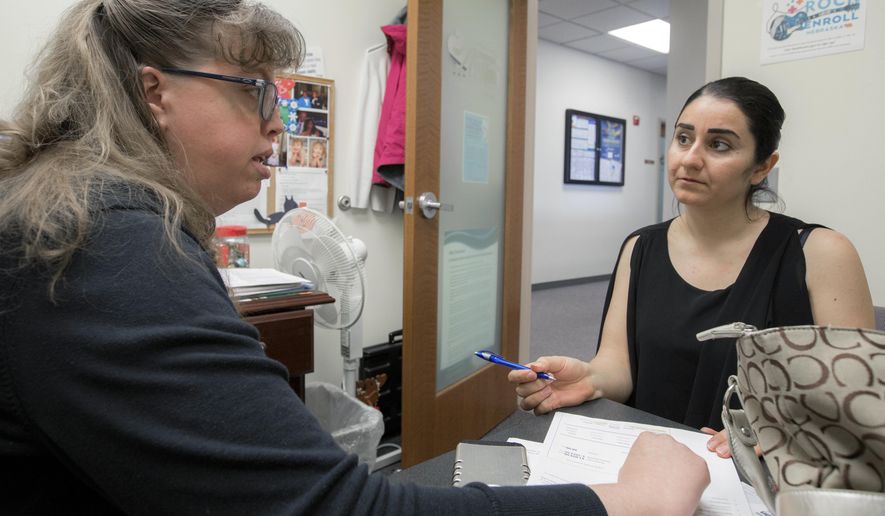LINCOLN, Neb. (AP) - The annual campaign to sign Nebraska residents up for health insurance through the federal marketplace could hit more snags than usual this year under new Trump administration policies, and advocates say rural areas will be hardest hit.
Open enrollment through the Affordable Care Act exchanges opened last week, but outreach groups that guide residents through the process will have far less time and money available to help.
The Trump administration cut the groups’ funding, slashed the law’s advertising budget by 90 percent and shortened the open enrollment period by half, to six weeks. The federal government also plans to shut down the enrollment website, Healthcare.gov, for up to 12 hours each Sunday during the enrollment, except on Dec. 10. Enrollment opened Wednesday and will end after Dec. 15.
“It’s kind of a multi-layered mess, to be frank,” said Chante Truscott, manager of the health insurance navigator program offered by Community Action of Nebraska, a statewide network that helps low-income people. “My hope is that we can make sure every Nebraskan has the opportunity to get health coverage. My fear is that this situation has created a perfect storm that will make that very difficult.”
Budget cuts have forced groups to reduce their staffs and travel costs, and the time constraints will make it much more difficult to visit rural areas, Truscott said. Community Action of Nebraska’s funding for navigators was slashed from $455,000 to about $75,000 this year, she said.
In past years, Truscott said navigators traveled to rural areas for residents who were homebound or lacked easy access to transportation.
“The biggest place where we cut was travel,” she said. “You have to make a little go a really, really, really long way. Overall, rural Nebraskans are the ones who are going to be short-changed.”
Advocates predict new enrollments will decline because of the lack of time, publicity, and misunderstandings about the law. In many cases, they’ve turned to their existing networks to re-enroll people who have used the service before.
Community Action Partnership of Lancaster and Saunders Counties has spent some of its remaining budget on local bus ads, a social media campaign and postcards that were sent to previous enrollees, said Serena Reeves, a health insurance navigator in the group’s Lincoln office. The Nebraska Department of Insurance has also provided referrals, she said, but the efforts aren’t as effective as prime-time ads on state and national television.
“It really is a big change,” Reeves said. “In years past, we haven’t done as much outreach with existing enrollees because we had three months and a lot of information out in the marketplace.”
Reeves said her agency started booking appointments early to squeeze in as many clients as possible, but the shortened timeframe will make it harder to see everyone before enrollment ends. Because of the constraints, she said she won’t spend as much time in Saunders County, a more rural area north of Lincoln, than in the past.
“You can only work so many hours in a week,” she said. “I just wish there was a little more of me to go around.”
Compounding the problem is a surprisingly widespread, and incorrect, belief that the Affordable Care Act is no longer in effect and that customers are no longer required to have insurance, said Molly McCleery, deputy director of health care for the advocacy group Nebraska Appleseed. McCleery said some people assume plans aren’t available in their area.
“There’s just a lot of confusion about where the ACA stands and what the options are,” McCleery said.
Others believe their premiums will skyrocket, even though most people who buy insurance through the marketplace will qualify for premium tax credits to keep the costs from rising, Reeves said.
The U.S. Department of Health and Human Resources released an analysis last week that shows the average tax credit will rise next year to $555, a 45 percent increase to offset higher premium costs. The report said 80 percent of enrollees will pay less than $75 per month in premiums. More Americans will qualify for subsidies during the current enrollment period because they’re based on insurance price tags and the federal poverty level, both of which are increasing.
Those who don’t qualify for subsidies could see sharp increases, in part because the Trump administration announced plans to cut off federal payments to insurers that provide discounts to the lowest-income policy holders. The discounts reduce the amount policy holders must spend on co-payments and deductibles. Insurance companies responded by raising their rates in many states to compensate for lost revenue.
Just one statewide insurer, Minnetonka, Minnesota-based Medica, will offer coverage in Nebraska through the exchange next year. Medica will provide a dozen different individual plans, with different levels of coverage.
___
Follow Grant Schulte on Twitter at https://twitter.com/GrantSchulte




Please read our comment policy before commenting.